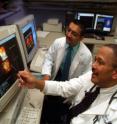Nuclear stress test can detect more than blockages
A less invasive test commonly used to diagnose coronary disease also may be used to detect one of the leading causes of heart failure, say researchers at the Medical College of Georgia. By using a nuclear stress test to look at how fast blood flows into the heart's pumping chamber – the left ventricle – they can determine if a patient's left ventricle is having trouble.
When the ventricle fails to properly fill with blood because it's stiff and unable to relax, it's called diastolic dysfunction, accounting for 40 to 60 percent of patients with heart failure, according to the American Heart Association. When it occurs, the left side of the heart pumps too little blood while the right side continues to pump normally, and the lungs fill up with blood.
"If someone has a slow fill rate, that means the left ventricle is not relaxed enough to get enough blood," says Dr. Dineshkumar Patel, internal medicine resident. "And if the left ventricle cannot receive enough blood, then it cannot collect enough blood to be pumped out to the rest of the body. There is a four-fold increase in morbidity and mortality when diastolic dysfunction is present in patients with coronary disease."
It is easier for physicians to test how well the heart pumps, called systolic function, using an echocardiogram and cardiac catheterization, says Dr. Patel.
An echocardiogram utilizes an ultrasound beam that travels through the front of the chest wall and lungs to the heart, and cardiac catheterization is a very invasive procedure using a thin plastic tube which is inserted into an artery or vein in the arm or leg and advanced into the chambers of the heart.
"But not all patients can undergo this test because it is so invasive," Dr. Patel adds. "And it's difficult to diagnose diastolic dysfunction with these [tests] when the systolic function is normal because you can have a perfectly normal pumping heart and still have this condition."
Dr. Patel collaborated with Dr. Vincent J.B. Robinson and looked at 52 consecutive patients who underwent cardiac catheterization within 15 days of a nuclear stress test to test the efficacy in diagnosing diastolic dysfunction.
During a nuclear stress test, radioactive thallium is injected into the bloodstream to show how well blood flows to the heart muscle. Scans are taken shortly after an exercise test to show blood flow when the heart is stressed and two or three hours later to show blood flow during rest.
"This test is usually used to identify blockages in the heart," Dr. Patel explains. "But in addition to the blockages, we have demonstrated that it also shows the left ventricle filling pressure, thus giving us an excellent prognostic value in predicting diastolic dysfunction because when the filling pressure is too high, the left ventricle has a hard time receiving blood."
Dr. Patel and the MCG nuclear cardiology research team compared the diastolic filling pressure from the catheterization and from the nuclear stress test and found that the latter had a 94 percent specificity in detecting diastolic dysfunction (i.e. high filling pressure at cardiac catheterization).
The nuclear stress test plots out a heartbeat in 16 frames, and that represents the diastolic filling curve at 16 points, like taking a melon and slicing it into 16 even pieces, says Dr. Robinson, nuclear cardiologist at MCG and the Charlie Norwood Veterans Affairs Medical Center of Augusta and faculty adviser on the study. The slope of the filling portion of the curve is a representation of the left ventricle filling pressure used as a marker of diastolic dysfunction.
"We have discovered that just looking at these markers can tell us whether a patient has diastolic dysfunction or not," says Dr. Robinson. "Diastolic function is a major prognostic factor in these patients with coronary disease. Previously, the nuclear stress test was only detecting diastolic dysfunction in patients who were already sick, whose hearts were weak and barely pumping."
"In other words, the test only picked up patients who had diastolic and systolic dysfunction," he says. "But now, we can use the diastolic filling curve on a nuclear stress test to diagnose patients with diastolic dysfunction who have normally squeezing hearts."
You can be in great physical shape and still have diastolic dysfunction, says Dr. Patel. "We can prevent heart failure before you start complaining of chest pain and shortness of breath."
Source: Medical College of Georgia
Other sources
- Detecting Coronary Disease Early: Nuclear Stress Test Can Detect More Than Blockagesfrom Science DailyThu, 17 Jul 2008, 1:28:14 UTC
- Nuclear stress test can detect more than blockagesfrom PhysorgMon, 14 Jul 2008, 15:42:08 UTC
